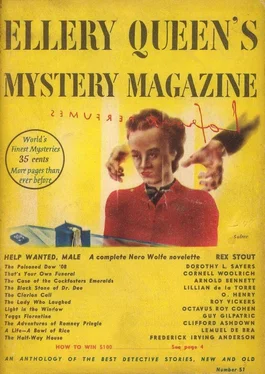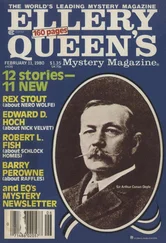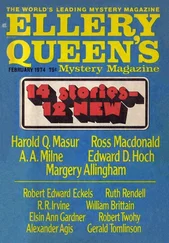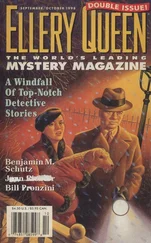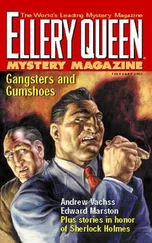Frederick Anderson - Ellery Queen's Mystery Magazine, Vol. 11, No. 51, February 1948
Здесь есть возможность читать онлайн «Frederick Anderson - Ellery Queen's Mystery Magazine, Vol. 11, No. 51, February 1948» весь текст электронной книги совершенно бесплатно (целиком полную версию без сокращений). В некоторых случаях можно слушать аудио, скачать через торрент в формате fb2 и присутствует краткое содержание. Город: New York, Год выпуска: 1948, Издательство: The American Mercury, Жанр: Классический детектив, на английском языке. Описание произведения, (предисловие) а так же отзывы посетителей доступны на портале библиотеки ЛибКат.
- Название:Ellery Queen's Mystery Magazine, Vol. 11, No. 51, February 1948
- Автор:
- Издательство:The American Mercury
- Жанр:
- Год:1948
- Город:New York
- ISBN:нет данных
- Рейтинг книги:3 / 5. Голосов: 1
-
Избранное:Добавить в избранное
- Отзывы:
-
Ваша оценка:
- 60
- 1
- 2
- 3
- 4
- 5
Ellery Queen's Mystery Magazine, Vol. 11, No. 51, February 1948: краткое содержание, описание и аннотация
Предлагаем к чтению аннотацию, описание, краткое содержание или предисловие (зависит от того, что написал сам автор книги «Ellery Queen's Mystery Magazine, Vol. 11, No. 51, February 1948»). Если вы не нашли необходимую информацию о книге — напишите в комментариях, мы постараемся отыскать её.
Ellery Queen's Mystery Magazine, Vol. 11, No. 51, February 1948 — читать онлайн бесплатно полную книгу (весь текст) целиком
Ниже представлен текст книги, разбитый по страницам. Система сохранения места последней прочитанной страницы, позволяет с удобством читать онлайн бесплатно книгу «Ellery Queen's Mystery Magazine, Vol. 11, No. 51, February 1948», без необходимости каждый раз заново искать на чём Вы остановились. Поставьте закладку, и сможете в любой момент перейти на страницу, на которой закончили чтение.
Интервал:
Закладка:
“Good Lord, they’ve all got Spengrave’s face!” ejaculated Rason. He caught Karslake’s eye and added defiantly: “I’m going to put the cards on the table with this bloke.”
For some minutes they sat in silence. Then the door opened. Both men gasped. Both were momentarily as confused as schoolboys.
“I’m sorry I had to keep you waiting, gentlemen.”
Spengrave was in make-up. They stared at the gray-white, idiot face of the Clown, the splash of carmine, harsh and hideous at close quarters, the bald wig, the conical cap.
“Perhaps we — perhaps you would rather we waited while you change, Mr. Spengrave?” faltered Rason.
“Quite unnecessary! You don’t imagine that I’m going to make jokes and fall over carpets.” The voice coming out of that preposterous face was both irritable and authoritative. “I’ve just been having stills taken of a new act. Sit down, please. What can I do for you?”
“We’ve come on a very serious matter, Mr. Spengrave. We have to put to you certain questions arising out of your wife’s death. If you refuse to answer, or if your answers are unsatisfactory, we shall have to ask you to come along with us.”
As Spengrave swung a swivel chair from his dressing-table the mirrors caught him in cross-reflection, so that Rason was compelled to contemplate the Clown face multiplied to infinity, staring into his.
“Go ahead, Inspector.”
“Can you describe the dress your wife was wearing at that party?”
“No. I’ve no eye for women’s dress and no memory.”
“That’s unusual in one of your profession, especially as you yourself were once a pictorial artist.” Rason was opening an attaché case. He took out a mill board, on which was a painting of a woman’s dress of green crepe.
“Is this the dress she was wearing?”
“It may have been,” he said. “I think it is.”
“Quite right. It is. Five of the women who were your guests that day have identified it.” Rason added: “I obtained a judge’s order to examine your furniture at the repository. That dress was in the wardrobe of the deceased! By the way, both the men and women guests remarked that they had not been allowed to see the poor lady after death.”
“That was nothing to do with me — the local police were in charge,” rasped Spengrave. “In any case it was unnecessary. I identified the body.”
“Yes, of course. After you had flown down from Edinburgh. The major examination had not then taken place. The body was almost exactly as it had been found in the gymnasium.” Rason leaned forward and tapped the picture of the green crepe dress. “Did you see that dress on the dead body of your wife?”
“I can’t remember.”
“You can’t remember!” echoed Rason. “Do you mean that you may or may not have seen that dress on the body?” As Spengrave assented, Rason produced a police photograph of the corpse taken in the gymnasium.
“That is the dress you saw in the mortuary. You can’t see the color, but the line of that dress is quite different. And here it is in color.”
Rason thrust at him a second mill board, a little crumpled and faded, on which was a painting of a red dress in velvet corduroy.
“Do you recognize that red velvet corduroy dress, Mr. Spengrave?”
“No,” snapped Spengrave “I’ve told you I’ve no memory for women’s dress.”
“But you’ve a memory for your own work, haven’t you? You designed that dress yourself. You painted the picture you have in your hand. It’s the dress she wore in her act with you — The Lady Who Wouldn’t Laugh.”
“By Jove, you’re right!” exclaimed Spengrave, as if surprised.
“On August 18th last year,” continued Rason, “you signed the book, in the keeping of your caretaker, for the key of the robe-room, or whatever you call it. You entered the robe-room with a suitcase. On August 21st, your chief dresser sent you a chit reporting that that dress was missing. You wrote on the chit ‘O.K.’ and initialed it. Why did your wife want that property dress, Mr. Spengrave?”
“I now remember the incidents you describe.” Spengrave spoke in the same authoritative, irritable voice. “But I don’t remember why my wife wanted that dress.”
“Let me suggest why you wanted her to have it, and you tell me if I’m wrong,” pressed Rason. “You created an act in which a girl is rolled in that carpet of yours. You asked your wife to play the girl and said you’d put on the act for the party. You fixed it so that she could slip into that carpet without anyone seeing her but you. And you fixed it so that someone should suggest rolling that carpet up. When Mr. Periss offered to do it you said, ‘Yes, please,’ thereby procuring the death of your wife. And that means murder.”
“You asked me to tell you if you were wrong,” chuckled Spengrave. “You are.”
“Maybe I’ve slipped up on a few details,” said Rason. “But do you deny that you created an act in which a girl is rolled up—”
“I deny it absolutely,” thundered Spengrave. “It would be an utterly futile act.”
“At the repository I found nothing in your desk — it was practically empty,” said Rason. “But under the cushion of the armchair that used to be in your study I found a manuscript in your handwriting. Here’s a typed copy. I don’t altogether understand stage directions. But there’s one bit where it says: ‘Clown kicks coil of carpet (laugh). Clown struggles with carpet. Fails. Walks away (laugh). Returns. Unrolls carpet. Girl sits up—’ ”
“All right!” Spengrave stood up. The figure of the clown facing destruction was not even tragic, only bizarre. “It will take me twenty minutes to change. Do you mind waiting in the foyer?”
“Sorry, Mr. Spengrave.” Again Rason’s eye traveled along the frieze — to the altar of lshtar, where the Clown is slain. “We shall have to stay with you.”
But, as is well known, Spengrave succeeded in shooting himself while he was changing, with the gun which he kept in a drawer for precisely that contingency.
Yeggs Florentine
by Guy Gilpatric [8] Copyright 1930, by Guy Gilpatric
Mr. and Mrs. Wells came out of the Grand Hotel and paused on the sidewalk looking around. “Nope, no taxi,” said Mr. Wells to the doorman. “Just going for a stroll to look the town over. Which way’s the Ponte Vecchio?”
They crossed the square and walked along the Lungarno Torrigiani, which runs beside the Arno. “Gosh, that’s a muddy river,” observed Mr. Wells. “I wonder what kind of fish those soldiers are trying to catch? Sunfish, I bet. Oh, yes, look, Mama, there’s the Ponte Vecchio there. Looks just like the pictures, doesn’t it?”
“Yes,” said Mrs. Wells, who hadn’t been listening. “I wish we’d had the car come ’round. I know we’ll get lost.”
“Yes? Well, I notice every time we roll up to any place in that Isotta, zip go the prices. The chauffeur gives the storekeepers a high-sign and gets maybe a twenty per cent rake-off on everything we buy.”
“Well,” said Mrs. Wells, doubtfully, “I’ve got an idea my feet are going to hurt. Oh, look here, Tom — here’s a jeweler here.”
“Sure,” said Mr. Wells. “But Faustino says they’re all yeggs on this side of the river, and he ought to know! We’ll go down to the bridge, cross over, and...”
“Wait a minute, Tom; do wait a minute. Now, look, Tom, there’s a nice one there — the one with the red stones, sort of.”
“Sure, he’s probably got a gross of them, all junk. Oh, look, Bella, see the way they’ve got shops built right on the bridge. Say, now, that’s interesting, isn’t it? I mean, it’s quaint, now, isn’t it?”
Читать дальшеИнтервал:
Закладка:
Похожие книги на «Ellery Queen's Mystery Magazine, Vol. 11, No. 51, February 1948»
Представляем Вашему вниманию похожие книги на «Ellery Queen's Mystery Magazine, Vol. 11, No. 51, February 1948» списком для выбора. Мы отобрали схожую по названию и смыслу литературу в надежде предоставить читателям больше вариантов отыскать новые, интересные, ещё непрочитанные произведения.
Обсуждение, отзывы о книге «Ellery Queen's Mystery Magazine, Vol. 11, No. 51, February 1948» и просто собственные мнения читателей. Оставьте ваши комментарии, напишите, что Вы думаете о произведении, его смысле или главных героях. Укажите что конкретно понравилось, а что нет, и почему Вы так считаете.
